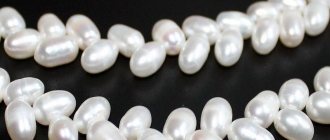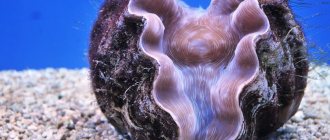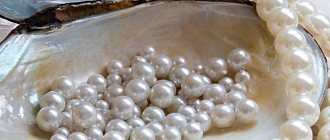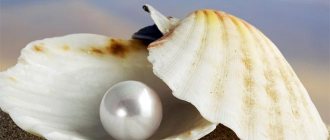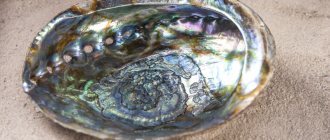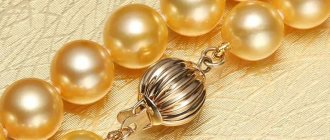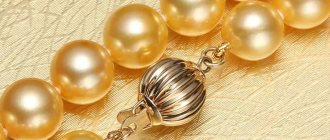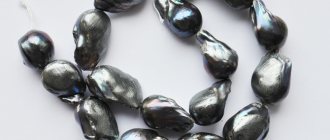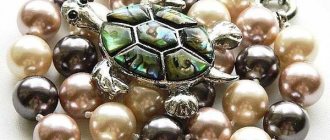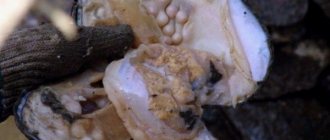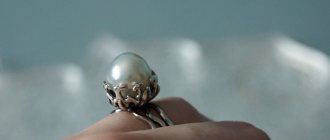What kind of pearls are there?
Pearl is a stone of organic origin, a product of the activity of a living organism. First, an irritant - a small parasite, a worm or a grain of sand - enters the body of a river or sea mollusk. The oyster defends itself by secreting mother-of-pearl and enveloping the stranger layer by layer from the core, center to periphery. The longer the prisoner is in the oyster, the thicker the layer of mother-of-pearl, and the stronger the pearl. This is how a jewel is made - from concentric layers in the mantle of a mollusk. Sometimes the stone grows to the surface of the shell valve.
Important point! Pearl is not the same as mother of pearl. Some types of pearls are formed without this component. For example, a pink variety called conch.
Harvesting wild pearls
In nature, one out of thousands of mollusks produces a pearl: such rarity and active hunting led to the extinction of oysters. The shortage of reserves became noticeable at the end of the 19th century. Therefore, the search began for ways to cause less damage to nature, while having stones at a lower price. Now almost the entire range on sale is cultivated.
Natural wild pearls are more of a collectible story at very high prices. In fact, since the 50s of the twentieth century, such hunting has been prohibited. In Australia, New Zealand, and Japan, fishing is permissible for local residents, but also with restrictions. No scuba gear or technical equipment: just handles!
Cultivation process
Cultured pearls are also produced with human input. They place a foreign object in the sink and wait for it to become overgrown with mother-of-pearl. On average, the process takes up to 7 years, during which time it is possible to grow a good pearl, provided that the mollusk does not reject the foreign object.
Pearls are formed because the oyster's sensitive mantle reacts to an object entering the shell. The mollusk produces a special substance - nacre - which gradually covers the foreign body.
Previously, evenly shaped pieces of clay, bars carved from wood, and glass beads were placed in the sink. Today, to obtain cultured pearls, special beads of a regular round shape are placed in the shell, resulting in an even, smooth pearl.
Pearls are grown on special farms. After beads are attached to the mollusk, it is released into the sea or river on a special net. River mollusks are more fertile, so up to 5 foreign bodies are placed in their shells. River pearls ripen faster, they differ:
- Size.
- Form.
- Shade.
Sea ones are larger and have a regular shape, river ones are small and often uneven, so their cost is lower.
The Japanese managed to learn how to influence the size of pearls and their shade. But in 2011, the tsunami destroyed a large number of farms, as a result, the leadership in pearl production passed to China. But Japanese craftsmen managed to grow pearls larger than 7 mm; the cost of such specimens is twice as high. Chinese pearls are no different in similar dimensions.
Cultured pearls
Cultured pearls are no different from wild ones, the cost of which can be considered fabulous.
In the first two to three years, the pearl grows quickly and becomes covered with nacre, then the process slows down. The longer the foreign body is covered with nacre, the better. This affects:
- Size.
- Quality.
- Wear resistance.
Pearls are a rather fragile material, they are susceptible to the negative effects of environmental factors and can lose their shine and color.
What affects:
- humidity;
- chemical reagents;
- cosmetics.
For this reason, jewelry with pearls should be stored in a separate case, protecting the jewelry from excessive humidity, reagents and cosmetics. Such products can be cleaned in various ways, but with proper storage and use, pearls will last at least 50 years without losing their external qualities.
What are cultured pearls
First of all: these are not artificial stones! They go through the same birth processes as wild finds. The seed can be either a small core of a mother-of-pearl bead or a square piece of mantle (mollusk epithelium).
The first attempts to grow mother-of-pearl balls date back to China in the 13th century. The Swedish botanist Carl Linnaeus was also involved in the development of technology and the chemical and biological description of the process in the middle of the 18th century.
Photo: Tumblr.com |
Williecreekpearls.com But the technology for creating cultured pearls is entirely the merit of Japan. Kokichi Mikimoto
patented a method of working with oysters, which the world still uses today.
In 1893
, Mikimoto presented the first round bead grown by humans in natural conditions.
Since 1921
, massive harvests of high quality Japanese Akoya oysters have been available on the world market.
Over time, stone prices plummeted as perfectly round, artificially grown akoyas flooded into jewelry stores. For the first time in the history of mankind, real strings of pearls became available to every housewife and working girl. By 1935
, there were 350 pearl farms in Japan, producing 10 million cultured beads per year.
But not everything is so simple. Two other factors influenced Mikimoto's success and fame.
1. In the Persian Gulf 1908
The oil business became the main one in the year. From now on, it has become a priority international industry in the region. How this has affected the environment today is already clear. And with it - the life of mollusks in particular.
2. Thanks to oil production, many industries developed. Among them is the production of plastic buttons. So what? Previously, mollusks were sought off the coasts of America and Australia specifically to create mother-of-pearl buttons. Since a synthetic analogue appeared, the demand for oysters also fell.
Photo: Lurich.com | Shreve.com
Healing and magical properties
Ancient Chinese healers used pearl powder. Thanks to its high calcium content, it helped strengthen the bone and muscle system. The mineral also has a positive effect on the kidneys, liver, and intestines. It normalizes their work and helps cope with excessive accumulation of toxins in the body.
In addition, wearing a stone can reduce fatigue, nervous tension, and overcome stress and its consequences.
The main magical property of pearl is protection and fight against old age. Even Queen Cleopatra revered this stone. She regularly wore strings or rings of pearls to maintain her youth and beauty.
Pearls are a symbol of purity and purity. It was believed that if a bride was presented with a string of pearls, it would protect her from bad deeds and infidelity.
What types of cultured pearls are there?
Saltwater cultured pearls: types
Akoya are classic white and round stones grown in salt water off the coast of Japan. Tahiti is the black pearl of French Polynesia and the Fiji Islands. Colors range from silver to blue, green and purple. South Sea pearls are large white or golden stones. The rarest form, growing off the coast of Australia and the Philippines.
Freshwater cultured pearls
Freshwater specimens are created by introducing implants in the form of mother-of-pearl balls not into the gonads (reproductive organs), but into the mantle of the mollusk. In this case, the beads themselves are pre-wrapped in the epithelium-sac of the Akoya oyster. It is into this bag that the nacre is then released, layer by layer forming a new pearl. One oyster can grow not just one, but as many as 12-16 pearls at once! Therefore, the cost of freshwater finds is much cheaper than sea finds.
Artificially coated cultured pearls, the outer layer of which does not consist of the nacreous layer secreted by the mollusk, are considered imitation
Photo: Thejewelleryeditor.com | Krishijagran.com
What do wild and cultured pearls have in common?
1. Both types of pearls are produced by the work of mollusks, which in the process secrete a complex scleroprotein called conchiolin and calcium carbonate in the form of aragonite and/or calcite, arranged in concentric layers. Each pearl is a unique, individual gem with its own character.
2. Both wild and cultured pearls are processed: bleached, tinted or irradiated to improve their appearance. The following processes are normal for treatment/treatment:
- oiling,
- filling,
- special coating compositions,
- drilling,
- waxing,
- cut,
- peeling,
- polishing,
- cleaning
At the same time, the documents must indicate such changes.
3. Both types require special care and storage conditions. We wrote a whole article about this.
4. No species can be identified by eye or tooth. The second method is for those who like to bite pearls with their teeth. It is possible to find out the origin in a gemological laboratory with the help of instruments and experience. Therefore, you should not “taste” store-bought jewelry or throw it on the floor to evaluate the quality of the jumps.
What is the difference?
The difference between natural pearls and cultured pearls can be seen in cross-section. In “wild” beads, no traces of seeding are often found inside. If the irritant was of organic origin - small parasites, living creatures. Over time, the seed succumbs to the process of decomposition and virtually disappears. In a cultured specimen, the “plant agent” is clearly visible when cut.
The most famous imitations
Pearls that are created entirely under human control are artificial pearls. Several imitation technologies are used, in the process of which ideal pearls are obtained, not inferior in beauty to natural minerals. This type of jewelry material is in demand in the consumer market.
Most manufacturers produce inexpensive beads used for jewelry, clothing decoration and interior items. So, in handicraft stores you can buy an imitation made of acrylic at a price of 500 rubles per package weighing 500 g.
Only a few manufacturers of artificial pearls differ in their pricing policies. These are well-known brands that guarantee the quality of mother-of-pearl.
Majorica
The Spanish brand uses technology that follows the natural development process of a pearl. It takes from 10 to 30 days to make one bead. An opaline crystal (frosted glass ball) is coated with several layers of mother-of-pearl essence. It consists of elements of natural mother-of-pearl, which gives the pearl shine and a unique iridescent shimmer.
After each application of the essence, the beads are polished and treated with ultraviolet light to eliminate any roughness on the surface. The final manufacturing stage includes 25 steps of quality control. The GIA Gemological Laboratory has concluded that Majorica has the characteristics of a superior quality sea white pearl.
Unlike natural mineral, which is more fragile, Majorica has high strength and is not capricious in relation to external irritants: perfume, sea water, sweat, sunlight. The velvety surface has a natural shade.
Swarovski pearls
Swarovski Crystal Pearls are another famous imitation mother of pearl stone. The required weight and size are selected using Swarovski crystals. Several layers of mother-of-pearl are applied to each one. High-tech equipment and high-quality raw materials are used in production.
Such pearl-like beads are more practical than natural ones. Their beauty does not change under the influence of external factors. The stones cannot be scratched and do not lose their shine. Swarovski pearls have a perfectly smooth surface. The price for a large size bead starts from 100 rubles.
Shell pearl
In the 20s of the last century, a technology for simulating natural minerals was created in America. The production scheme is as follows: a pressed ball or hemisphere of oyster shells is carefully polished, then several layers of natural mother-of-pearl essence are applied. The blanks are repeatedly dipped into a special solution. The result is a perfectly polished artificial stone.
Pearls are painted in a variety of colors. Features of Artificial Shell Pearl:
- smooth surface;
- non-toxic material;
- durable mother-of-pearl coating;
- a wide palette of colors and a variety of bead shapes;
- affordable price.
Cultured and artificial pearls are not inferior in beauty and quality to natural ones. Such minerals are used to make jewelry and branded costume jewelry. Cheap beads are made by molding plastic or acrylic. The second option for a cheap copy is a glass ball filled with mother-of-pearl mass.
Mabe pearls (Mabe, Mabe pearls)
Mabe pearls are artificially created pearls. The manufacturing technology is as follows: a plastic dome (core) is attached to the inner surface of the mollusk valve.
After 6-12 months, the resulting pearl is drilled from the outside with the shell flap. Then the core is removed from the pearl, leaving a hollow shell. It is tinted or painted from the inside with paint or matrix mother of pearl. After this, the nacre shell is filled with epoxy resin and topped with matrix nacre. Of course, mabe pearls, which have epoxy resin inside, are much cheaper than real ones.
Advantages and disadvantages
The main advantage of cultivation is the guarantee of careful treatment of shells. When extracting natural materials, pearl mussels are often damaged, not giving the mollusk a chance to continue life. On farms, one shell is used to create 4-5 stones, after which it is returned to its usual habitat.
Also, the advantages include the high strength of minerals. Artificial pearls are much stronger than natural pearls and can withstand external influences. Another advantage is price, since cultured samples will cost less than mined minerals.
There are practically no disadvantages to cultured pearls, with the exception of the low strength of river pearls.
Pearl cultivation is an interesting process that is practiced by farmers in different countries. It allows you to carefully grow beads in the most suitable conditions. There are many types of precious peas; in the photo it is not always possible to appreciate all the beauty of the minerals.
Features and Methods
A mineral created by human hands cannot but be considered natural. The created material cannot be considered artificial, despite the process taking place under the control of reason and science. The pearl cultivation system is a complex job that requires accuracy and painstaking care. It can only be compared with jewelry making and the creativity of craftsmen. The farmer cannot say exactly what the result of his work will look like in the end, just like the craftsman.
They create an image in their head, then reproduce it on the surface of the stone. The naturalness is also confirmed by the fact that it is impossible to accurately determine the date of rejection of the pea. Regardless of a person’s wishes, material is rejected. We wrote more about the types and properties of pearls here.
There are few methods for creating a pearl. Scientists have developed two main methods:
- Nuclear.
- Nuclear-free.
Saltwater pearls are the first to be grown. The nuclear-free method creates the freshwater appearance of the gemstone.
Nuclear technology
The method is based on certain actions. Cultivation begins with the search for a donor pearl mussel. A young clam will do. They check the quality of his robe. This is the scientific name for a mother-of-pearl shell. The second indicator is the quality of development of the reproductive gland (gonad). The creation of conditions for precious material can be compared to an operation. How to go about it:
- Open the shell using special tools.
- Make a small cut in soft tissue.
- Place a piece of donor robe into the incision.
- Remove the ball from a freshwater oyster.
- Place a small ball next to the graft.
After all the careful manipulations carried out with the shell, it is returned to the lagoon and left alone for several years. This technique does not provide a 100% guarantee of obtaining the desired result. The pearl mussel may die, and the nucleus is often rejected. But if everything goes well, a pearl will form. It is common for an artificially grown mineral to have a special layer of pearlescent coating. In a year it reaches a height of 1 cm.
The nuclear method of creation can hardly be called unnatural; most of the process takes place under natural conditions.
What are cultured pearls? In this case, it is helping the natural material to fulfill the instructions given by man. What is the difference between the two pearls? When you get it in your hands, you can easily tell what the difference is. A real mineral is colder and heavier, an artificial one is light and quickly heats up from the temperature of the human body.
Nuclear-free technology
Cultivating a precious mineral in this way is not so difficult. That is why most pearls up to 8 mm in size are created using this development. Although the method is called nuclear-free, the role of the core is still retained. A miniature grain of mother-of-pearl sand is suitable for it. She is taken out of the sink. The type of habitat does not matter. Both can be used:
- nautical;
- freshwater.
Physico-chemical properties of pearls
Pearl is an organomineral consisting of an aggregate of calcium carbonate and a horny substance, conchiolin. In other words, a calcareous organic compound that arose as a result of the protective reaction of the mollusk body to a foreign substance.
Advertising - Continued below
Pearls come in a variety of colors: cream, silver, pink, white, dark gold and even blue and black. There are more than a hundred shades. The palette depends not only on the types of pearl mussels, but also on the place of their birth, the chemical composition of the water and the maturity of the pearls themselves. Maturity is measured in microns of thickness of the aragonite plates. The most brilliant, and therefore the highest quality, layers are considered to be those with a thickness of half a micron. Basically, these are not river pearls, but sea pearls.
Pearls are a very fragile and delicate gemstone. Its hardness is only 3-4 on the Mohs scale, and it is easily scratched by any sharp object. Density ranges from 2.6 to 2.78 g/cm3.
When exposed to X-ray or neutron irradiation, freshwater pearls darken to black; sea pearls react to irradiation only with the core, remaining light on the outside.
It is also worth noting that pearls have their own varieties, and their names mainly come from their appearance: baroque pearls (pastel delicate shades and irregular shapes), blister (fused to the shell of the pearl oyster), soufflé pearls (bright and airy due to their hollowness), caches (Japanese seed pearls), kasumi (obtained only from the lake of the same name in Japan) and the rarest pale pink conch. You can read more about all types of pearls in the article.
Recognition methods
Many instructions have been invented explaining how to distinguish natural pearls from artificial ones. Actions are divided into visual, mechanical and formal.
Video: How to distinguish artificial pearls from natural ones?
Visual
Conducted at home. The following characteristics are assessed:
- weight;
- surface cleanliness;
- shine;
- structure.
It is believed that they are practically not counterfeited, because it's difficult.
Weight
The most advanced polymers are not able to replicate the weight parameters of pearls, so simply by holding a bead, it is easy to find out whether it is a natural material.
Pure mother of pearl is heavier than glass or plastic. It is made heavier by the natural stone - the core, around which layers of pearls grow.
Before determining whether pearls are natural or artificial, consider the following:
- When making pearls, mother of pearl is added, so the weight of the artificial product is close to natural;
- An artificial colored mineral is sometimes made from germanite (black pearls are obtained) or coral (pink) - it is heavier than real analogues.
Colored natural pearls are more expensive than white ones. If upon purchase it turns out to be the other way around, then it is a painted fake.
Surface
Nature rarely creates perfectly smooth, clean surfaces. Even elite pearls have small flaws in the form of indentations or roughness. Cultivated specimens are smoother, but also not flawless. The smoothest pearls are natural from auctions or synthetic.
Natural pearls have randomly located spots. They are formed by conchiolin and shine less than the main background in the light.
Shine
The quality of gloss is determined in natural light. Based on this feature, the origin of pearls is determined near a window or on the street.
In a natural specimen, light creates bluish, pinkish or other tints on the surface. It is impossible to obtain them by treating the product with the best varnish or pigment.
A variety of shades is not a defect, but a normal property of natural material. Uniformity, sameness of colors and shades indicates that the selected pearls are of artificial origin.
Structure
Glass or polymers used to imitate natural pearls are easily recognized by their smooth, smooth surface.
In natural material, it is porous and layered, because in natural conditions the core grows in layers slowly, by 0.25–0.35 mm per year, that is, the creation of even a two- to three-millimeter bead takes years.
You can examine the surface in detail and distinguish a fake under a microscope or magnifying glass.
The easiest way to identify beads is by this feature. When choosing a necklace, you need to look at the edge of the inner hole through a magnifying glass. If the beads were coated with paint, its accumulation will be noticeable. Sometimes stone or glass can be seen under the paint.
Form
A fake pearl is perfectly round. However, such natural specimens are rare; oblong, oval, and pear-shaped ones are more common.
Mechanical
Not all methods are safe or easy to apply, but to know how to distinguish pearls, they are taken into account.
Dental check
This is the first thing they recommend doing to check your pearls.
A real mineral creaks when it comes into contact with teeth. Pearlescent powder remains on them, and the unevenness of the surface is felt. Chemicals and glass can be identified without problems in this way.
However, not every salon will allow such an experiment.
Friction
Pearls rub against each other. If they are natural, pearl dust will appear at the friction site, but the surface will not be damaged.
Conducting an in-store experience is also problematic.
Strength
Natural pearls are indifferent to mechanical stress. When checking the pearl for authenticity, it is dropped onto the table. Impact result:
- natural - the appearance of cracks or scratches that are easy to erase;
- glass will crack or break;
- polymers will remain intact.
Heavy natural pearls fall like a stone, light plastic bounces like a ball.
Fitting
You can easily determine its authenticity by holding the bead in your hands or trying on the necklace. At any temperature you will feel the coolness emanating from natural samples. The jewelry will reach room temperature and will quickly heat up in your hands.
X-ray
The photo will reflect the inside of the pearl - density, structure, and other characteristics.
Ultraviolet
To determine the origin, the specimen is placed under an ultraviolet lamp or similar light source. The natural mineral creates a gentle blue glow, the cultivated one creates a greenish glow.
Fire
Whether pearls are natural or not can be determined by applying heat. Nothing will happen to natural things even near fire.
Vinegar
The method is rather theoretical, since only a fake can remain unharmed in strong vinegar. If the pearl dissolved, it means it was real.
Formal
No interaction between the buyer and the precious mineral is required. But the question of how to reliably determine whether a real pearl is real or not is removed.
Price
One of the most reliable methods. Natural pearls, including cultured ones, are never cheap. It is not offered at attractive prices, since the first one is rare, the second one takes a long time and is labor-intensive to grow.
For example, an ideal 10 mm sea pearl is valued at $400, and the same 15 mm is already $1,500. It’s better not to count how much the necklace will cost.
Plastic or glass analogues are two orders of magnitude (a hundred times) cheaper.
Place of purchase and documents
To avoid problems with distinguishing natural pearls from fakes, beads or jewelry are purchased at a reputable salon. But even if the product is from trusted manufacturers, it is a good idea to request a quality certificate.
Visit to a specialist
In order for doubts to be completely dispelled, a professional analysis of the jewelry using special instruments is required. Gemologists or jewelers have them.
Interesting varieties
There are cultured pearls with amazing names: “Akoya”, “Mabe”, “Tahiti”. We’ll tell you what it is now.
The first species began to be cultivated in China and Japan. The mineral is obtained from sea shells. The correct shape of the stone increases the price and classifies it as expensive jewelry. At the same time, the size of the pearls is small - only 4-9 mm. However, the color is unusual. Mother of pearl is white and very shiny. The development of technology has made it possible to expand the palette and obtain black, pink and gold shades
“Tahiti” is a cultured pearl that is not directly related to the island of the same name. There is simply a center there where ready-made stones or production oysters are brought.
Despite the fact that the Tahitian mineral is associated with the color black, the stones are often born gray, but always with regular round or pear-shaped shapes. The parents are shells of mollusks called pearl mussels Margaritifera, which are bred in Vietnam, Australia and the Seychelles. This species is characterized by a metallic sheen. The colors are varied - blue, green, red, olive. The most valuable are iridescent blue and cobalt.
The variety called “Mabe” has a different shape. This is a hemisphere, which is obtained by fixing the implant in the sink near the wall. This means that a half-pearl will be born. Manufacturers – Japan and southeast Asia. Dimensions are on average 10-20 mm in diameter. The colors are delicate - pink, light blue, white and silver. The mineral is not very durable, which is one of its disadvantages.
Growing methods
There are now only two technologies for growing pearls - nuclear and non-nuclear. In both ways, the growth of jewelry lasts for years (this is a business with a long payback period).
It takes a mollusk several years to grow a pearl of jewelry value, since it grows approximately a millimeter or two in diameter per year. The specific period depends on the method of cultivation, water temperature, type of mollusk and other conditions.
All methods of growing pearls are based on a simple surgical operation - carefully opening the mollusk in order to place a “seed” in it - the basis of the future jewel.
Nuclear
This method involves the use of two or even three different mollusks - a mantle donor, a seed nucleus donor and a recipient, a kind of “surrogate mother”.
From an invertebrate that has a well-developed gonad - a reproductive gland that secretes nacre - a piece of the mantle (the soft layer between the body and the shell) is taken. It is implanted into the mantle of the recipient oyster to increase and speed up the release of nacre.
From another or the same donor, a seed core is taken - a tiny pearl of the shape that they want to get as a result, and is placed in the mantle cavity of the recipient next to the mantle implant. Sometimes cheap freshwater pearls are used as the core. The main thing is the form.
Having a perfectly round core, you can get a perfectly round large pearl.
Mostly saltwater cultured pearls are obtained this way.
Saltwater cultured pearls
After these procedures, the mollusk is sent back to the sea to “ripen.” The chances of successful implantation are 60–70%. The invertebrate may reject it or simply die. But if this does not happen, after a while - from two to five years - the oyster is taken out to obtain finished pearls.
Nuclear-free
The only difference between this method of growing pearls is that the implantation of a particle of the mantle of another invertebrate is not used, and any solid substances are used as a seed - fragments of the shell of the same or another oyster, grains of sand and similar substances.
The nuclear-free method is simpler and cheaper, but does not allow you to control the shape of the pearls. This method is used to produce mainly freshwater baroque pearls, the value of which lies precisely in the whimsicality of their shapes. There are quite a few types of pearls, varying in size and color.
Baroque freshwater pearl pendant
Sea and river “parents”
Sea and river cultivation are somewhat different. When using oceanic mollusks, a small particle is artificially placed into their reproductive organs (gonads). This could be, for example, a tiny fragment of a shell. The body of a living creature immediately reacts and begins to work, covering the alien body with layers of mother-of-pearl.
To get the correct round shape, the source must initially be a ball. After 5-8 months of work, the precious stone is ready, but the coating will still be thin. A full-fledged shell is formed within 1.5-2 years.
When growing freshwater pearls, the implant is inserted into the mollusk's mantle. This method allows you to introduce several foreign bodies at once and ultimately obtain up to 16 precious stones from one shell.
The growth time of pearls is influenced by the environment, type and age of the oyster. In young shells the process goes faster. Mollusks living in seawater produce large stones, since the biochemistry is richer in the sea.
How is it different from artificial pearls?
The imitation is created from cheap materials. It does not have the physical and magical properties of its precious counterpart. The first thing you need to pay attention to is the cost of the product. A low price is a sure sign of a cheap fake. There are also several other ways to check whether a stone is real:
- Surface. Artificial specimens are predominantly in the shape of a sphere, drop, hemisphere or rice. At the same time, there are completely no defects on the surface. Natural pearls are rarely this perfect.
- Hardness. Imitation pearls are even less durable than cultured pearls. It is very easy to scratch.
- Size. Beads of the same diameter are quite rare. Although laboratory-produced material has more similar dimensions, they still do not have to be identical.
Fake pearls often lose their color if they are rubbed or wet. Real pearls can only be affected by prolonged exposure to sunlight, chemicals and excess moisture.
How to distinguish a natural mineral from its imitation
You can distinguish fake beads or a bracelet made from fake Burmitz grain using the following signs:
- Non-natural pearls look absolutely perfect; they are distinguished by their impeccable evenness and smoothness, and their round shape. Natural mother of pearl, which develops without human intervention, may have some errors.
- Imitation pearls are always lighter than natural minerals.
- All beads in a jewelry made from fake pearls have the same size and shape; in a necklace made from a natural mineral, the beads can have different parameters, although this is not always noticeable at first glance.
- The shine of unnatural Burmitz grain lacks the depth of the shine of the real thing.
- Imitation pearls in beads have the same color and tone, while real pearls sparkle in different shades.
- If you look closely at the holes that are drilled in the pearls in order to pass the thread, you will notice that the artificial mineral is chipped, and the material from which they are made, for example, plastic, is visible through them.
- Non-natural pearls, such as acrylic ones, will not be as cool to the touch as real minerals. Natural Burmitz grain always with its coolness resembles the depth of the waters in which it was mined, and artificially created pearls quickly take on the temperature of the room where they are located.
Also, the imitation mineral is easily susceptible to external influences; if it is slightly scratched, no traces will remain on natural Burmitz grain. In addition, dust, high humidity, strong sunlight, and temperature changes contribute to the rapid aging of beads made from unnatural minerals. A real pearl necklace can retain its original appearance if properly stored for 150-200 years. There are cases where a family heirloom pearl has been passed down from generation to generation for 400 years.
Freshwater pearl species
Such a stone grows at the bottom of lakes and rivers, hence the name - fresh water. In China, rice fields are used for technology. They are perfect for the internal climate for the propagation and maturation of mother-of-pearl jewels. Peasants check the indicators of the water area:
- water temperature;
- liquid composition;
- acidity indicators.
Farmers turn the pearl oyster over to make the beads perfectly round. The freshwater species comes in a variety of shapes, colors and sizes. The peas turn out to be unusually attractive. Common sizes are 5–7 mm. Large specimens can also be obtained - up to 1 cm. The price of the samples depends on the diameter. The most popular variety is Hyriopsis schlegeli. Her family is Unionide. The appearance has its own differences: a brownish surface, white walls of the insides. Approximate growth time:
- after 2 years – 2.5 mm;
- after 5 years – 6 mm;
- 7 years – 8 mm;
- 9 years – 1 cm.
River creature shades:
- snow-white;
- peach;
- pink;
- lily;
- pale purple.
The shapes of the stone can also be different. Perfectly round outlines will become rare. More often it is an oval, an egg, a drop or a potato.
Cultivation or production of artificial pearls
The artificially grown mineral has several varieties. The most famous of them are Mallorca pearls. This variety is also called Orchid, the pearls are made of porcelain, glass or plastic. They are covered with artificial mother of pearl. They are also treated with nitrocellulose or cellulose acetate chemicals to strengthen them. Beads made from pearls of this type are very reminiscent of products made from cultivated Burmitz grain.
Another type of mineral is called shell pearls; if you ask about how they are grown, you can hear the answer that the beads are coated with polyamide and varnish, which consists of particles of mica, plastic and other substances. This type of imitated mineral is considered the newest and most often used in jewelry.
Another type of imitation mineral is Venetian pearls, which, when asked how they are made, you can hear that they are created from blown glass coated with pearls. The beads are not hollow; wax is poured into them. Earrings decorated with Venetian pearls look very beautiful and do not look like cheap jewelry.
One of the oldest methods of creating unnatural Burmitz grain is the Parisian or French method, which was invented in the 1600s and is still popular today. When creating French pearls, blown glass beads are simply filled with wax.
